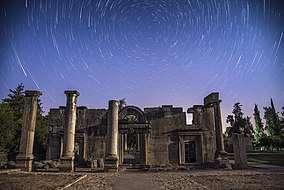Kfar Bar'am
Kfar Baram (Hebrew: כְּפַר בַּרְעָם), is the site of an ancient Jewish village. It is situated near to the site of Kafr Bir'im or Kafar Berem, a medieval Maronite Christian village. Today, it is located in Northern Israel, 3 kilometers from the Lebanese border.
 Ancient synagogue ruins. | |
 Shown within Israel | |
| Location | Northern District, Israel |
|---|---|
| Coordinates | 33.043611°N 35.414075°E |
Etymology
The name is often assumed to mean "Son of the People," incorporating the Aramaic word bar בר, meaning "son" and the Hebrew word am עם meaning "people". However, if like at Shfar'am, both elements are Hebrew, the name could derive from a literary Hebrew word בר indicating cleanliness, purity, pristineness and wholesomeness - "The wholesome people" or "wholesomeness of the people".
History
Bar'am was established in ancient times as a Jewish village. According to Jewish tradition, Pinchas ben Yair (2nd-century CE) was buried in Kfar Bar'am.[1] At an unknown point between the 7th and the 13th century, Jews abandoned the village.[2][3] After a period of Muslim inhabitation,[4] by the 19th century the village was entirely Christian, comprising Maronites and Melkites.[5] A church on the site, the Maronite church, is maintained and is in regular use.
The village was badly damaged in the Galilee earthquake of 1837. The local church and a row of columns and other standing remains of the ancient synagogue were thrown to the ground.[6]
The nearby village of Kafr Bir'im was captured October 31, 1948 by the Israel Defense Forces during operation Hiram and the villagers forced to leave.[7] In 1949, due to frequent cross-border infiltration, they were barred from returning to the border zone.[8] On June 16, 1949, Kibbutz Bar'am was founded nearby by demobilized Palmach soldiers.
Archaeology

The Kfar Bar'am synagogue is preserved up to the second story and has been restored. The architecture is similar to that of other synagogues in the Galilee built in the Talmudic period. In 1522, Rabbi Moses Basula wrote that the synagogue belonged to Simeon bar Yochai, who survived the Second Jewish War in 132-135 CE (the Bar-Kochba revolt). Archaeologists, however, have concluded that the building was built at least a century later. According to another tradition, the synagogue was built in honor of Rabbi Shimon bar Yochai, and bore his name.[9] Israeli archaeologist Lipa Sukenik (1889–1953), who was instrumental in establishing the Department of Archaeology at the Hebrew University, excavated a relief in one of the synagogues in 1928, and dated the Bar’am synagogue to the 3rd century CE.
The synagogue is made of basalt stone, standard for most buildings in the area. The six-column portico is unusual. The front entrance of the synagogue has three doorways that face Jerusalem. In front of the entrance are some of the (originally eight) columns with Attic bases which supported a porch. There is an inscription under the right window on the facade, which reads: "Banahu Elazar bar Yodan", which means "Elazar bar Yodan built it". Elazar bar Yodan is a Jewish Aramaic name. The interior of the synagogue was divided by rows of columns into three aisles and an ambulatory.
An unusual feature in an ancient synagogue is the presence of three-dimensional sculpture, a pair of stone lions. A similar pair of three-dimensional lions was found at Chorazin.[10] A carved frieze features a winged victory and images of animals and, possibly, human figures.[11]
There was a second, smaller synagogue, but little of it was found. A lintel from this smaller synagogue is at the Louvre. The Hebrew inscription on the lintel reads, "Peace be upon the place, and on all the places of Israel."[12]

In 1901, publication of photos of the ancient synagogue led the Jewish Hospital of Philadelphia, (now the Albert Einstein Medical Center,) to erect a synagogue, the Henry S. Frank Memorial Synagogue, inspired by Bar'am and other ancient Israeli synagogues. The hospital's synagogue replicated the round arch of the door of the standing ruin and the lintel from the smaller synagogue that is now in the Louvre.[3]
See also
- Ancient synagogues in the Palestine region
- Archaeology of Israel
- Bar'am National Park
- Oldest synagogues in the world
References
- Burial Places of the Fathers, published by Yehuda Levi Nahum in book: Ṣohar la-ḥasifat ginzei teiman (Heb. צהר לחשיפת גנזי תימן), Tel-Aviv 1986, p. 252
- Judaism in late antiquity, Jacob Neusner, Bertold Spuler, Hady R Idris, BRILL, 2001, p. 155
- Art and Judaism in the Greco-Roman world: toward a new Jewish archaeology, Steven Fine, Cambridge University Press, 2005, pp. 13-14
- Hütteroth and Abdulfattah, 1977, p. 175
- Robinson and Smith, 1856, pp. 68-71
- "The earthquake of 1 January 1837 in Southern Lebanon and Northern Palestine" by N. N. Ambraseys, in Annali di Geofisica, August 1997, p.933,
- Benny Morris (2004): The Birth of the Palestinian Refugee Problem Revisited, ISBN 0-521-00967-7, p. XXII, settlement #160.
- Palestine's border wars, 1949-1956: Arab infiltration, Israeli retaliation, and the countdown to the Suez War, Benny Morris, 2nd Edition, Oxford University Press, 1997, p. 124
- Burial Places of the Fathers, published by Yehuda Levi Nahum in book: Ṣohar la-ḥasifat ginzei teiman (Heb. צהר לחשיפת גנזי תימן), Tel-Aviv 1986, p. 252 (Hebrew)
- Art and Judaism in the Greco-Roman world: toward a new Jewish archaeology, Steven Fine, Cambridge University Press, 2005, p. 190.
- Art and Judaism in the Greco-Roman world: toward a new Jewish archaeology, Steven Fine, Cambridge University Press, 2005, p. 92.
- Art and Judaism in the Greco-Roman world: toward a new Jewish archaeology, Steven Fine, Cambridge University Press, 2005, Chapter 1, Building an Ancient Synagogue on the Delaware, pp. 12-21
External links
- Bar'am synagogue (Talmudic period)
- Ancient Synagogues in Bar'am and Capernaum article written by Jacqueline Schaalje, from Jewish Magazine, June 2001 Edition
- Bar’am National Park, an ancient synagogue and a Maronite church
- Coexistence - Kafar Berem article written by Hanna F. Farah